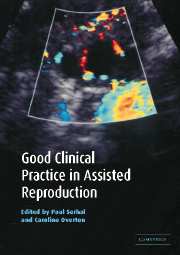Book contents
- Frontmatter
- Contents
- List of contributors
- Foreword by Bob Edwards
- Preface
- 1 Clinical assessment of the woman for assisted conception
- 2 Clinical assessment and management of the infertile man
- 3 Laboratory assessment of the infertile man
- 4 Donor insemination
- 5 Treatment options prior to IVF
- 6 Strategies for superovulation for IVF
- 7 Techniques for IVF
- 8 Ovarian hyperstimulation syndrome
- 9 Early pregnancy complications after assisted reproductive technology
- 10 Oocyte donation
- 11 Surrogacy
- 12 Clinical aspects of preimplantation genetic diagnosis
- 13 Controversial issues in assisted reproduction
- 14 Alternatives to in vitro fertilization: gamete intrafallopian transfer and zygote intrafallopian transfer
- 15 Counselling
- 16 Good nursing practice in assisted conception
- 17 Setting up an IVF unit
- 18 Information technology aspects of assisted conception
- 19 Assisted reproductive technology and older women
- 20 Ethical aspects of controversies in assisted reproductive technology
- Index
- Plate section
14 - Alternatives to in vitro fertilization: gamete intrafallopian transfer and zygote intrafallopian transfer
Published online by Cambridge University Press: 22 October 2009
- Frontmatter
- Contents
- List of contributors
- Foreword by Bob Edwards
- Preface
- 1 Clinical assessment of the woman for assisted conception
- 2 Clinical assessment and management of the infertile man
- 3 Laboratory assessment of the infertile man
- 4 Donor insemination
- 5 Treatment options prior to IVF
- 6 Strategies for superovulation for IVF
- 7 Techniques for IVF
- 8 Ovarian hyperstimulation syndrome
- 9 Early pregnancy complications after assisted reproductive technology
- 10 Oocyte donation
- 11 Surrogacy
- 12 Clinical aspects of preimplantation genetic diagnosis
- 13 Controversial issues in assisted reproduction
- 14 Alternatives to in vitro fertilization: gamete intrafallopian transfer and zygote intrafallopian transfer
- 15 Counselling
- 16 Good nursing practice in assisted conception
- 17 Setting up an IVF unit
- 18 Information technology aspects of assisted conception
- 19 Assisted reproductive technology and older women
- 20 Ethical aspects of controversies in assisted reproductive technology
- Index
- Plate section
Summary
Assisted conception comprises techniques that allow a couple's infertility to be treated by bringing together their gametes and subsequently transferring gametes or embryos into the female reproductive tract.
Gamete intrafallopian transfer (GIFT)
GIFT involves a direct transfer of human gametes, sperm and oocytes into the fallopian tubes. The first successful pregnancy following the use of this technique was reported by Asch et al. in 1984, and is used to treat infertile women with patent tubes and has now become established procedure.
In the natural environment, the fertilized oocyte reaches the uterine cavity approximately five days after release from the ovary, that is, on day 19 of a 28-day menstrual cycle. The slow progress of the embryo permits progesterone-stimulated endometrial maturation. Once the embryo reaches the uterine cavity, an additional 24 to 48 hours pass before implantation occurs. The tubal and endometrial secretions, which bathe the conceptus, may promote implantation. By placing oocytes and sperm into the fallopian tube, GIFT attempts to mimic this natural state and may overcome deficiencies in the natural transport of gametes to the ampullary tube that account for the infertility.
Recent data demonstrate a 34.4% clinical pregnancy rate, with the highest pregnancy rate achieved in women who are infertile due to endometriosis or unexplained infertility (Abramovici et al., 1993).
Indications
Unexplained infertility.
Endometriosis.
Male factor infertility.
Cervical factor infertility.
Pre-requisite
At least one normal patent fallopian tube on previous laparoscopy (the preferred method of pelvic assessment) or hysterosalpingogram.
Ideally, proven fertilization either through embryos created during a previous IVF cycle or previous natural pregnancy regardless of its outcome.
Keywords
- Type
- Chapter
- Information
- Good Clinical Practice in Assisted Reproduction , pp. 256 - 265Publisher: Cambridge University PressPrint publication year: 2004
- 1
- Cited by

